Sand Perch
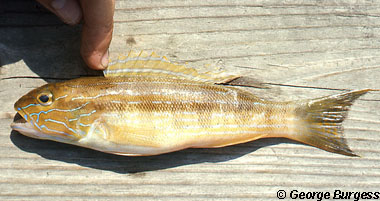
Diplectrum formosum
These small in-shore fish are territorial and loyal to the home hole or crevice that they have made or found. They are brown on top, fading to white underneath, with darker vertical bars, a mid-line stripe ending in a dark spot at the tail, and irregular blue horizontal lines. They have large eyes, a continuous dorsal fin, and a concave caudal (tail) fin. Rarely growing more than 9 inches long, they prefer shallow bays or reefs, where they eat crustaceans and small fish and avoid being eaten by larger fish.
Order – Perciformes
Family – Serranidae
Genus – Diplectrum
Species – formosum
Common Names
English language common names for D. formosum include sand perch, sand seabass, sandfish, sandperch, and squirrelfish. Common names in other languages are arenero (Spanish), bolo (Spanish), canguito (Portuguese), margarida (Portuguese), michole-da-areia (Portuguese), mixole (Portuguese), sandbarsch (German), serran de sable (French), serrano (Spanish), serrano arenero (Spanish), serrano-da-areia (Portuguese), toge-fudehata (Japanese), and vestatlantisk sandhavaborre (Danish).
Importance to Humans
This serranid is fished commercially as well as a gamefish although it gives a disappointing fight due to its small size. Despite its small size, it is popular as a pan fish due to its good taste. Sand perch are also caught and utilized as grouper, snapper, and shark bait. Sand perch can be taken with line and hook, using cut squid or shrimp and is often taken by fishers off the shoreline, bridges, and small boats. Shrimp trawlers also sometimes catch sand perch. Special care should be taken when handling sand perch due to the sharp gill plates. If approached by divers and snorkelers, sand perch will frequently hide.
Conservation
The sand perch is currently not listed as threatened or endangered with the World Conservation Union (IUCN). The IUCN is a global union of states, governmental agencies, and non-governmental organizations in a partnership that assesses the conservation status of species.
> Check the status of the sand perch at the IUCN website.
Geographical Distribution
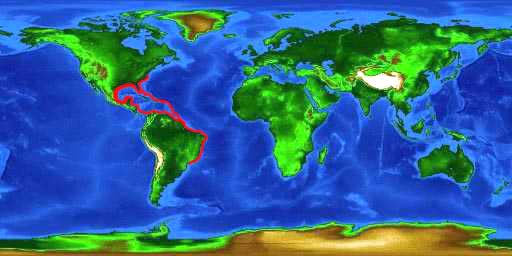
The sand perch is found in the western Atlantic Ocean from North Carolina (US), the Gulf of Mexico and Bahamas, south to Uruguay. It is common off the coast of Florida (US) and rare to absent throughout the western Caribbean.
Habitat
Inhabiting shallow bays and seagrass beds at depths from 3-262 feet (1-80 m), the sand perch is primarily a warm-water, inshore fish. When it is observed offshore, it is commonly associated with wrecks and reefs or occasionally deep channels. The sand perch lives in holes in the sandy bottom or under rocks. The holes are either pre-existing, made by other organisms, or the sand perch excavates a new hole. It lies on the bottom, vibrating its body to push the sand away. A hole may be utilized by the same fish for long periods of time, primarily as a shelter in which to dart into when predators approach. Sand perch do not school as territoriality tends to space individuals apart. These territories increase as the size of the fish increases.
Biology
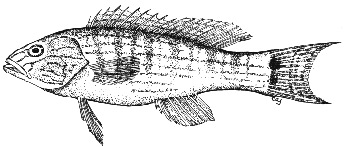
Distinctive Features
The sand perch has an elongate, slender, slightly compressed body. The head, eyes, and mouth are large and the gill plates are sharp. There are two clusters of spines projecting between the eyes and gill cover. The dorsal fin is continuous without a notch, rather than separated into two portions. This dorsal fin runs almost the entire length of the back. The pelvic fin of the sand perch is long and the caudal fin is slightly forked or concave. The upper lobe of the caudal fin is longer than the lower, with the uppermost ray sometimes filamentous, in the northern subspecies, while the caudal fin is truncate in individuals of the southern subspecies.
Coloration
The body is pale brown on the back and sides, fading to white on the belly. There are five to seven vertical bars on the body ranging from yellowish-brown to tan. These bars are more prominent during rest. There is also a conspicuous, dark mid-body stripe, ending with a dark spot on the upper half of the caudal penduncle. The sand perch can change the coloration of this stripe and the bar pattern from pale to dark, very quickly. Bright blue lines run across the head and body; there may also be some orange and blue shading on the sides in some individuals. All fins are dusky in color, the caudal fin also has light orange blotches, while the dorsal fin is marked with longitudinal blue and yellow lines.
The sand perch is similar in appearance to the dwarf sand perch (D. bivittatum), however there are some distinguishing characteristics. The dwarf sand perch has spines radiating from a single center rather than two areas as in the sand perch. The dwarf sand perch also has a triangular black spot on the upper part of the gill cover and irregular vertical dark bars on either side.
Dentition
Villiform teeth are present in the upper and lower jaws of the sand perch. There are 5-10 small caniform (canine-like) teeth in both jaws. The vomer, an unpaired median bone along the roof of the mouth, has villiform teeth (fine teeth of uniform length) in a wedge or v-shape arrangement. The palatines (paired lateral bones on the roof of the mouth located between the vomer and upper jaw) include a thin, elongate band of villiform teeth.
Size, Age, and Growth
The sand perch reaches a maximum length of 12 inches (30 cm), although they are observed more commonly at sizes from 5-9 inches (13-23 cm). Maximum age of the sand perch is probably from 6-7 years. This fish reaches maturity at lengths of 5 inches (12.5 cm), corresponding to an age of 2 or 3 years.
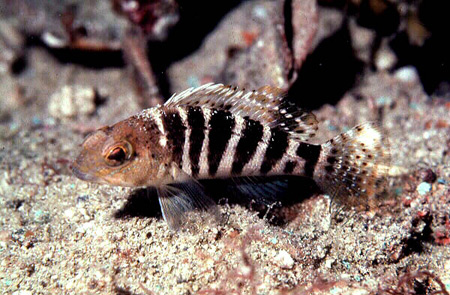
Food Habits
As a bottom inhabitant of reefs and rocky areas, the sand perch feeds primarily on benthic crustaceans, including shrimps, crabs, and amphipods, as well as small fishes such as small sea bass (Centropristis sp.), sea robins (Prionotus sp.), gobies, blennies, flatfishes (Symphurus sp.), and filefish (Monacanthus sp.).
Reproduction
Spawning activity occurs throughout the year with a peak during spring and early summer. Most spawning occurs offshore in deep shelf waters ranging from 328-656 feet (100-200 m) in depth. Sand perch are synchronously hermaphroditic fish – individual fish possess both male and female organs, producing sperm and eggs at the same time. Although mating behavior in sand perch is relatively unknown, it is believed that mating pairs form and result in cross-fertilization. Rather than building nests, they release eggs and sperm into the surrounding water column where external fertilization occurs. Upon hatching, the young planktonic larvae swim to inshore habitats where they will stay until reaching maturity. Characteristics of the larvae include a slender body as well as pigmentation on the jaw, anus, anal fin base, and caudal peduncle. As they grow, the juvenile fish inhabit shallow waters of 30-89 feet (9-27 m), moving offshore during winter months due to drops in water temperatures. Young sand perch settle out of the plankton, becoming demersal at lengths of less than 4 inches (10 cm).
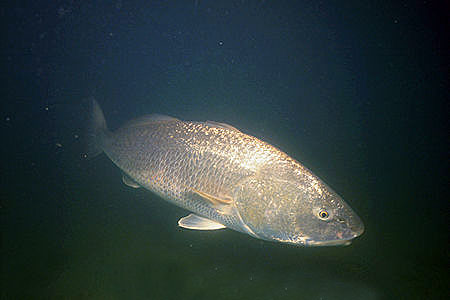
Predators
Predators of the sand perch include snappers, groupers, red porgy (Pagrus pagrus), red drum (Sciaenops ocellatus), bull sharks (Carcharhinus leucas), and various sea birds. Other large piscivorous fish such as jacks and barracudas probably also prey on the sand perch.Parasites
Parasites of the sand perch include nematodes and trematodes. Lecithochirium parvum, a trematode, was found in the stomach of a sand perch from the Florida panhandle region. The nematode, Hysterothylacium reliquens has also been associated with the sand perch.
Taxonomy
Carl Linnaeus (1766) originally described the sand perch as Perca formosa, which was later changed to the currently valid scientific name Diplectrum formosum. Synonyms for this serranid include Serranus radians Quoy and Gaimard 1824,Serranus fascicularis Valenciennes 1828, Serranus irradians Valenciennes 1828, Diplectrum fasciculare Holbrook 1855,Centropristis fascicularis Gunther 1859, Centropristis radians Poey 1876, Diplectrum radians Poey 1876, Serranus formosus Jordan 1885, Centropristis formosus Berg 1895, Haliperca formosa Miranda-Ribeiro 1904, Diplectrum formosusJordan 1930, and Diplectrum fascicularis Poey 1955. Two morphologically distinct populatons of Diplectrum formosumwere identified by Bortone (1977). In the north, Diplectrum formosum formosum (Linnaeus, 1766) occurs along the North American Atlantic coast and the Gulf of Mexico while the southern subspecies, Diplectrum formosum radians (Quoy and Gaimard, 1824) is found in the Caribbean Sea and along the South American coast. These two subspecies differ primarily in the number of gill rakers, increasing in number from north to south.
Prepared by: Cathleen Bester